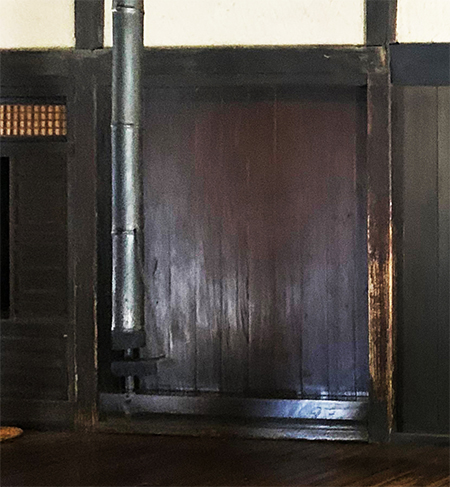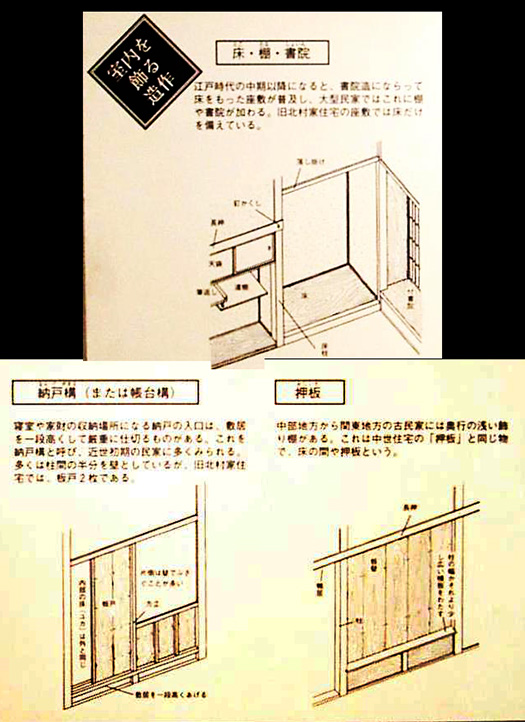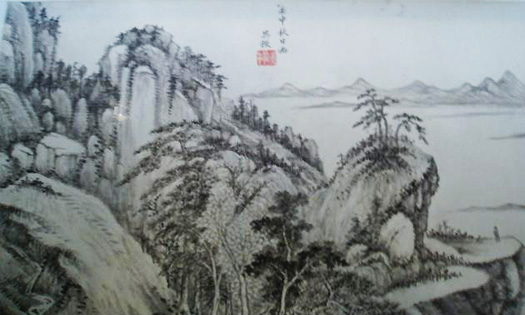

床・床の間の起源については諸説あるとされますが、
以下のような理解が一般的とされます。
〜「床の間」の起源は室町時代にさかのぼる。歌会や茶会を催す時、
壁に掛け軸をかけ「押板」と呼ばれる板の上に、美術品をおいて鑑賞した。
今日のような形になったのは桃山時代から江戸時代初期にかけてのこと。
「床の間」は、落掛(おとしがけ)床柱(とこばしら)床框(とこがまち)という
木材で四角く囲まれている。〜ということだけれど、
古民家を取材すると、そのルーツとしての「押板」を見ることが多い。
〜厚い板の意で転じて床 (とこ) と同様の場所をさす。近世の床の起源と考えられ
床より奥行が浅くかまちが高い位置に設けられる。13~14世紀に流行した
軸装の宋元画を鑑賞するためにつくられたとされる。〜というもの。

上写真は中国の墨絵ですが、こういう絵柄を日本的空間で楽しむ、
というようなアジア的感受性を涵養してきたのでしょうか?
畳という敷物は日本独特であり、そういう意味では
軸装されたこうした絵画は、最初期「異国情緒」を楽しむものだったかも。
畳敷きの「落ち着く」空間で中国的芸術に親しんだ。
日本人が民衆レベルで芸術を楽しんだ初源であるのかも知れない。
初源においてはこの押板というものが日本人の趣味的空間を
育ててきたと言えるのでしょう。
実物の「押板」空間装置はわたしも最近初めて目にできた次第ですが、
どうしてこういう空間が日本人に好まれ、
またそこから「床の間」というように進化していったのはなぜか、
という問いかけが提起されてきて、非常に興味深いと思っています。
アジア的には絵画と書というものが芸術鑑賞であったとされる。
とくに日本と中国で「軸装」という掛け軸文化が隆盛していった。
中国の場合は、詩と絵画は一体として表現され、
一方日本では、書は書、絵画は絵画だけというスタイルが主流になった。
どちらもここ千年くらいの間に盛んになったのだとされています。
このような紙に描かれた絵画の掛け軸を受け止める空間として
押板は歴史的に誕生していったのでしょう。
そう考えると木製の「数寄心」醸成装置とでも言えるのかも知れない。
逆に言うと、こういう装置が建築的に用意されるほどに
芸術作品が一般に流通していたとも言えるでしょう。
印刷という大量生産が普及する前の一品生産の芸術品で
押板のある家毎に多数の芸術品が蓄積されていたことになる。
掛け軸の数十本くらいはそこそこの家なら持っていて当たり前だったか。
識字率の高さといい、こういう芸術の普及率もまた、
世界有数であったともいえるのだろうか。
わが家はブロック造ということもあり
また、ほとんどが板の間の居室ばかりで、
畳の間は1部屋の寝室だけだったので、床の間はない。
なにか、重大な日本人的なるものの喪失だったのかもと
やや後ろめたい気分にも駆られております。・・・
English version⬇
[Tokonoma and Oshiita]
There are various theories about the origin between floors,
The following understanding is common.
~ The origin of “Tokonoma” dates back to the Muromachi period. When holding a song or tea ceremony
I hung a hanging scroll on the wall and placed the artwork on a board called “Oshiita” for viewing.
It was from the Momoyama period to the early Edo period that it became like today.
“Tokonoma” is called “Otoshigake” floor pillar (Tokobashira) floor stile (Tokogamachi).
It is surrounded by a square of wood. But
When we interview an old folk house, we often see the “Oshiita” as its roots.
~ Turns to mean a thick board and refers to the same place as the floor. Considered to be the origin of modern floors
It is installed at a position where the depth is shallower than the floor and the stile is high. Popular in the 13th-14th centuries
It is said that it was made to appreciate the Song dynasty painting of the shaft. ~something like.
The above picture is a Chinese sumi-e, but you can enjoy this kind of pattern in a Japanese space.
Have you cultivated such Asian sensitivities?
The rug called tatami is unique to Japan, and in that sense
These paintings on the axis may have enjoyed the “exotic atmosphere” at the beginning.
I became familiar with Chinese art in the “calm” space of tatami mats.
It may be the first source of Japanese enjoying art at the people’s level.
At the beginning, this push plate is a Japanese hobby space.
It can be said that it has been raised.
The real “push plate” space device was the first time I saw it recently,
Why are Japanese people like this kind of space?
Why did it evolve from there to “Tokonoma”?
I think it is very interesting because the question has been raised.
In Asia, painting and calligraphy are said to have been art appreciation.
Especially in Japan and China, the hanging scroll culture called “axle” became popular.
In the case of China, poetry and painting are expressed as one,
On the other hand, in Japan, the style of calligraphy is calligraphy and painting is only painting.
Both are said to have flourished in the last millennium.
As a space to receive the hanging scroll of paintings drawn on such paper
The push plate may have been born historically.
With that in mind, it may be said that it is a wooden “several spirit” cultivating device.
To put it the other way around, such equipment is architecturally prepared.
It can be said that works of art were in circulation.
It is a one-piece work of art before mass production of printing became widespread.
A large number of works of art were accumulated in each house with a push plate.
Was it natural to have dozens of hanging scrolls in a decent house?
It is said that the literacy rate is high, and the penetration rate of such art is also
Is it one of the best in the world?
Because my house is made of blocks
Also, most of them are living rooms between boards,
There was only one bedroom between the tatami mats, so there was no alcove.
Maybe it was a serious loss of Japanese things.
I feel like I want to be a little behind.・ ・ ・
Posted on 4月 21st, 2021 by 三木 奎吾
Filed under: 住宅マーケティング, 住宅性能・設備







コメントを投稿
「※誹謗中傷や、悪意のある書き込み、営利目的などのコメントを防ぐために、投稿された全てのコメントは一時的に保留されますのでご了承ください。」
You must be logged in to post a comment.